Table of Contents

Veal meat is the 7th most consumed type of meat in the United States with an average consumption of 0.33lbs per person yearly. (1)
When it comes to cow meat, people seem to be more familiar with beef and not many of them know about the nutritional values of veal.
In this article, we gathered all the useful information you need to know about veal meat including the nutritional values and health benefits of veal , the precautions you need to know before consuming veal alongside tips on how to buy + consume + store it.
But first…
What is veal meat?
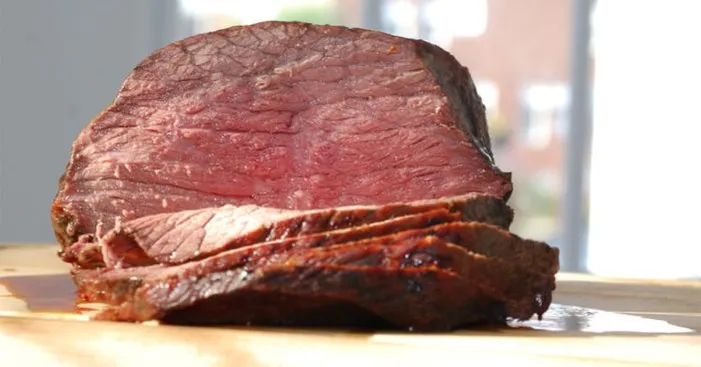
Veal is the meat derived from young male cows AKA « little bull”.
In fact, cows give birth to male and female little cows known as calves or heifers.
The female calves grow to become adult cows and replace the mother in producing milk and giving birth to more cows.
On the other hand, young male cows are either grown to become adult bulls used for breeding or for their strong pulling muscles…
Let’s not forget that farmers raise cows for gain purposes therefore even old bulls that are not suited for breeding or strength end up used for meat production as well.
However, a lot of small male cows don’t even make it to maturity instead they are used for veal meat production.
To conclude, veal meat is the delicate and firm meat that comes from small male cows that didn’t pass 6 months (24 weeks) of age. (2)
Difference between veal meat and beef:
Veal is very different from beef and there are a lot of criteria to distinguish between them including:
Beef characteristics:

Color, flavor, and texture:
Beef has a relatively weak flavor compared to veal meat which is why it needs flavor enhancers like spices and herbs.
Since beef is the meat of a mature cow, it has more tissues and tendons that make it tougher to chew.
Also, mature cows have already consumed different types of herbs and that gives their meat a darker color.
Age:
Commonly, people consider a cow adult after it gives birth to its first calf which usually happens between 2 and 3 years of age. (3)
Based on that, beef is the meat that comes from cows that already passed 3 years of age.
More specifically, when a cow reaches 6 years of age it yields the most meat which makes it perfect for beef production.
Nutritional values:
Beef is often recommended as a good food source for a healthy diet since it offers many minerals and vitamins.
Nonetheless, beef tends to have high calories (230 per 3.5oz) and it is mostly due to the fat content of 17g.
Price:
Beef meat is sold for 4 or 5$ per Kilogram which is 3 times more expensive than chicken. (4)
Veal meat characteristics:
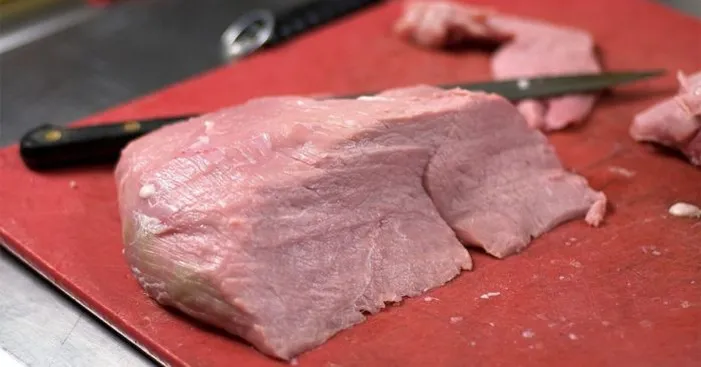
Color, flavor, and texture:
The flavor of veal doesn’t stink and requires minimum flavor enhancers as you can literally cook it without spices or herbs.
As for the color, small calves feed on their mother’s milk which makes veal meat light-red almost pink in color. (5)
In terms of the texture, veal meat has a very delicate flavor that almost melts in the mouth.
Age:
Generally, veal comes from small calves that didn’t pass 6 months of age.
Most veal meat comes from small bulls as they are unable to produce milk which makes meat the only way to yield profit from them.
Nutritional values:
Cow meat in general is lower in value whenever the color is lighter and this can be because of poor nutrition or the young age of the calf.
Based on that, veal is beneficial but it has a light red color which means it has lower nutritional values compared to beef mainly in terms of iron, zinc and vitamin B12 amounts. (6)
Nonetheless, it is leaner than beef as it has lower calories (172 per 3.5oz) and less fat with just 7.6g.
Price:
Veal is sold anywhere between 12 and 20$ per pound which is 3 to 4 times more expensive than beef. (7)
This is because a small cow would only yield between 50 and 100lbs of meat, unlike adult cows which give up to 500lbs. (8)
Therefore, farmers sell veal meat for a higher price as they only produce a small amount of this type of meat.
Veal meat health benefits and nutritional values:
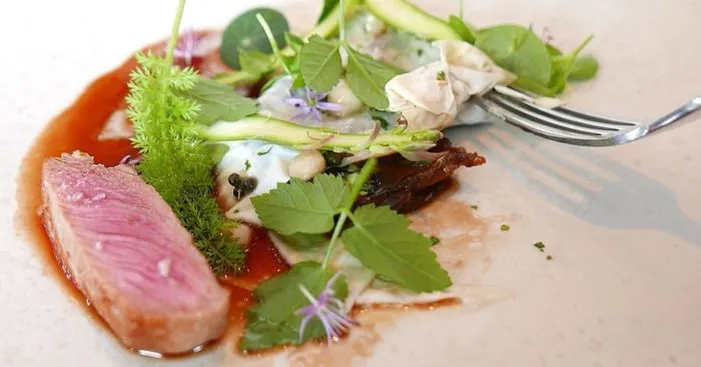
Nutritional values:
Veal meat offers about 32% of the daily need for complete protein for an adult person.
It is also a good source of minerals and vitamins essential for many body functions.
This type of meat can be excellent for a healthy diet since just 1 serving of 3oz (85g) offers 20% of the daily need in both zinc and selenium.
Zinc is an essential mineral that the body needs to build muscles, heal wounds, and many other body functions.
In addition, veal offers a good amount of linoleic acid which has been associated with many benefits.
This data counts for a serving of 3oz (85g) of cooked veal meat: (9)
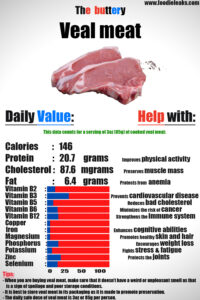
- Calories: 146
- Protein: 20.7g
- Cholesterol: 87.6mg
- Fat: 6.4g
- B2 vitamin: 13%
- B3 vitamin: 35%
- B5 vitamin: 10%
- B6 vitamin: 17%
- B12 vitamin: 18%
- Copper: 5%
- Iron: 5%
- Magnesium: 5%
- Phosphorus: 18%
- Potassium: 8%
- Zinc: 22%
- Selenium: 17%
Health benefits:
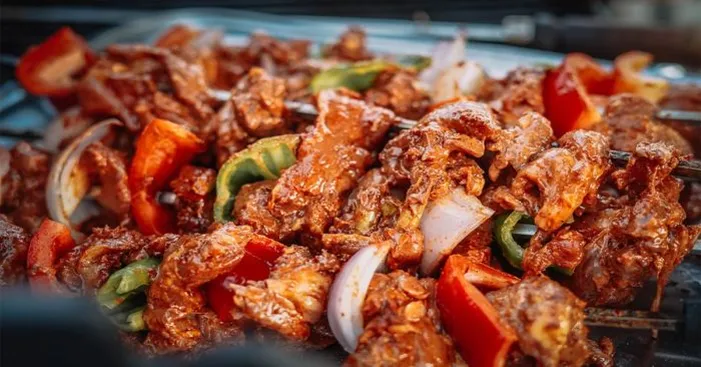
Here are some of the benefits a person could get from consuming veal meat:
Improves physical activity:
One of the most abundant nutrients in veal meat is beta-alanine which the body uses to create carnosine.
Carnosine is an essential compound the body uses to maintain muscle functions and improve performance.
Several studies confirm that high levels of carnosine enhance stamina, and improve strength and running time. (10)
Preserves muscle mass:
Like most types of meat, veal is a great source of complete protein as it contains the 9 amino acids the body needs from an external source.
Nutritionists recommend veal especially for the elderly to counter their lack of protein consumption and muscle breakdown. (11)
However, a shortage in protein consumption can also limit the muscle growth of children which affects their overall growth.
Athletes and those who use a lot of physical activity can count on veal meat as a protein source to help restore their muscles.
Protects from anemia:
Anemia occurs when the body has a low number of red blood cells therefore a lower ability to transfer oxygen to the different cells.
Consequently, the person feels weak most of the time and minimum physical activities would feel like too much to do.
One of the most common causes of anemia is iron deficiency and this is where veal meat can be very beneficial. (12)
In fact, just a serving of veal meat (3oz, 85g) offers about 5% of the daily need in Iron.
It may seem not too much but the good thing about veal meat is that it offers an easy-digestible iron.
Other benefits of veal meat:
- Prevents cardiovascular diseases.
- Reduces bad cholesterol.
- Minimizes the risk of cancer.
- Strengthens the immune system.
- Improves cognitive abilities.
- Promotes healthy skin and hair.
- Encourages weight loss.
- Fights stress and fatigue.
- Protects joints, bones, and muscles.
Precautions before you consume veal meat:

Generally, veal meat has almost no possible health dangers but there are always exceptions.
For instance, this type of meat is not recommended for people that suffer from joint problems such as gout.
This is because veal contains purine which promotes the production of uric which causes joint inflammation. (13)
However, the benefits and side effect of veal meat is very linked to the method of preparation.
Fried veal should not be given to people who already suffer from gastrointestinal tract infections.
In addition, some people may experience an allergic reaction to cow meat including beef and veal meat.
When you buy veal, try to avoid the brands where the product is a result of heat treatment as that makes the meat unhealthy. (14)
Cooking veal meat:
Veal meat sauce:
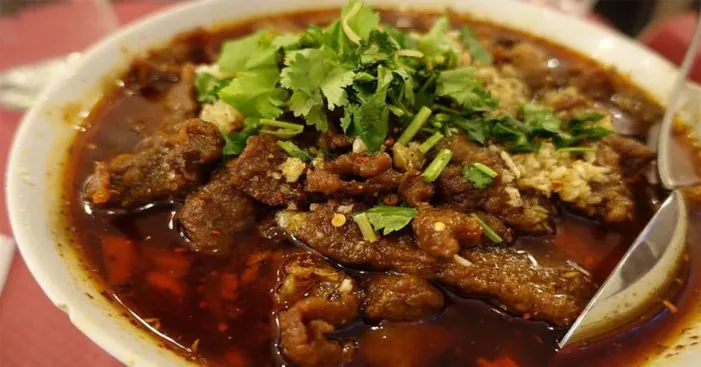
Ingredients:
- 1lb of veal cut into cubes (450g)
- Parsley.
- 2 onions.
- 2 Shallots.
- 1 tbsp of butter.
- 2 tbsp of flour.
- 2 cups of water.
- 1 tsp of salt and ground pepper.
Preparation:
- Start by chopping parsley, one onion, and peeled shallots together.
- Melt the butter in a pan then chop the second onion and fry it alongside the pieces of veal meat.
- Once the meat is brown, flip to the other side and let them brown too.
- Now sprinkle the chopped onion, parsley, and shallots.
- Add the flour and stir the ingredients using a wooden spoon as they cook over low heat (180°F, 80°C).
- When the flour turns golden, pour a cup of water then add salt and pepper.
- Add tomato paste and chopped mushrooms, stir for 1 minute then add another cup of water.
- Cover the pan and let it cook over low heat (180°F, 80°C) for 1 hour.
- If the sauce becomes too thick you can add another cup of water.
- After an hour, the pieces of veal meat should be thoroughly cooked otherwise let the mixture cook for an additional 10 minutes.
- That’s it! You can serve the veal sauce on top of pasta or alongside mashed potatoes for 6 people.
Veal meat in the oven:

Ingredients:
- ½ lb of veal (250g).
- 3 tbsp of butter.
- 3 tbsp of tomato paste.
- 1 cup of vinegar.
- 1 cup of cooking broth.
- 2 tbsp of flour.
- 1 tbsp of corn oil.
- 1 chopped onion.
- 2 chopped garlic cloves.
- 1 tbsp of lemon.
- 1 tsp of salt and ground pepper.
Preparation:
- Preheat the oven to 350°F (180°C).
- In the meantime, sprinkle flour on the pieces of veal meat to coat them thoroughly.
- Melt the butter in a pot then fry the pieces of meat for 5 minutes on each side until they turn brown.
- Take the pieces of meat out of the pot and place them on a piece of cloth to drain the butter.
- Add onion, garlic, tomato paste, cooking broth, lemon zest, salt, ground pepper, and vinegar and stir them with a wooden spoon as they cook in the pot.
- Bring the sauce to a boil then let it cook for an additional 5 minutes before you turn off the heat.
- Place the browned pieces of veal meat in the oven tray then pour the sauce on top of it, cover it with aluminum foil then place the tray in the oven.
- Let it cook for 90 minutes then take it out and serve it hot for 3 people.
Tips:
Roasting:
Cook veal meat in the oven wrapped in aluminum with little to no oils or butter for about 60 minutes at 150°F (65°C). (15)
Boiling:
To boil veal you can totally submerge it in boiling water.
Use different parts of veal meat with and without bones to obtain a piece of meat rich in flavor and texture.
Frying:
Sear veal meat on both sides over high heat for 5 minutes each then turn down the heat and let it cook for 10 minutes at low temperature (150°F,65°C).
However, avoid grilling pieces of meat that have bones as those require almost constant stirring.
Buying veal meat:
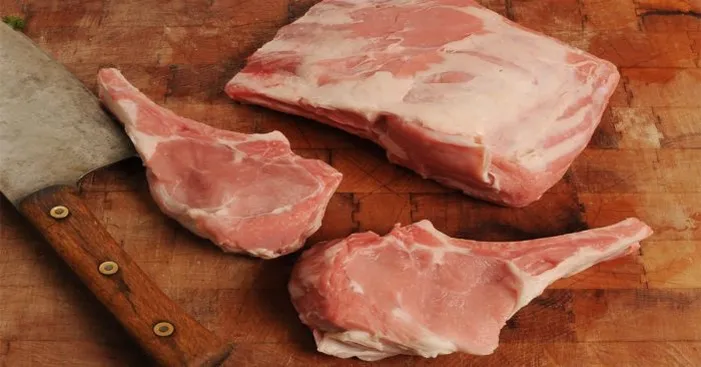
The pieces of veal meat can be different and sometimes it becomes confusing to know which part is the one you need for your dish.
Because of that, there are a few tips to choose the best piece of veal meat based on your recipe.
Here are a few tips you can use:
For roasting:
- Loins.
- Thigh pieces.
- Shoulder pieces.
- Bottom rack.
For grilling:
- Veal cutlets.
- Tenderloins.
- Veal ribs.
For boiling and stews:
- Veal shank.
- Tail.
- Tendons.
Nonetheless, regardless of the piece of veal you are buying, there are general things you should pay attention to:
- No weird or unpleasant smell should be felt as that is a sign of spoilage and poor storage conditions.
- When you press it with your finger, the texture of raw veal should feel very tender and less resistant than beef.
- If the piece of meat contains a fat layer it should be milky white in color and not yellowish.
- Veal meat contains little to no fat marbling.
- Make sure it is well sealed and the package has no holes or ice in it.
Storing veal meat:
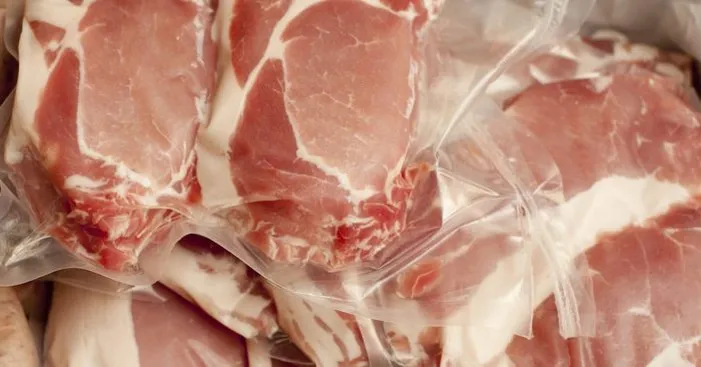
Once you got your veal meat from the store, you need to quickly place it in the fridge.
Generally, it is best to store veal in its packaging as it is made to promote preservation.
Veal meat remains fresh and edible for 3 days when stored in the fridge.
Nonetheless, you can keep meat for up to 1 week if you vacuum seals it.
In addition, you can freeze veal for up to 9 months in a freezing bag or an airtight container.
In case you froze it, make sure you take it out of the freezer and let it thaw overnight in the fridge before you cook it and that is the safest way to do it. (16)
References:
(1): The most consumed meat and fish in the USA » Supplement SOS
(2): What is veal? | RSPCA Assured
(3): At what age does a female calf become a cow? – Beef Cattle (extension.org)
(4): • Average prices for meat (beef) worldwide from 2014 to 2025 | Statista
(5): Science of Cooking: Ask the Inquisitive Cooks! (exploratorium.edu)
(6): Veal vs Beef – Health impact and Nutrition Comparison (foodstruct.com)
(7): https://www.dartagnan.com/buy/veal/
(8): How Much Meat Can You Expect from a Fed Steer? (sdstate.edu)
(9): Veal, raw, ground nutrition facts and analysis. (nutritionvalue.org)
(10): https://www.ncbi.nlm.nih.gov/pmc/articles/PMC8300828/
(11): Protein and muscle health during aging: benefits and concerns related to animal-based protein – PMC (nih.gov)
(12): Anemia: Symptoms, Types, Causes, Risks, Treatment & Management (clevelandclinic.org)
(13): Purine-Rich Foods and Gout – Rheumatic Diseases Center – Everyday Health
(14): Chemicals in Meat Cooked at High Temperatures and Cancer Risk – NCI
(15): A guide to internal cooking temperatures for beef, veal, lamb, pork and poultry | Living a Life in Colour
(16): How to Defrost Meat Fast — Methods to Thaw Meat Safely and Quickly (goodhousekeeping.com)
